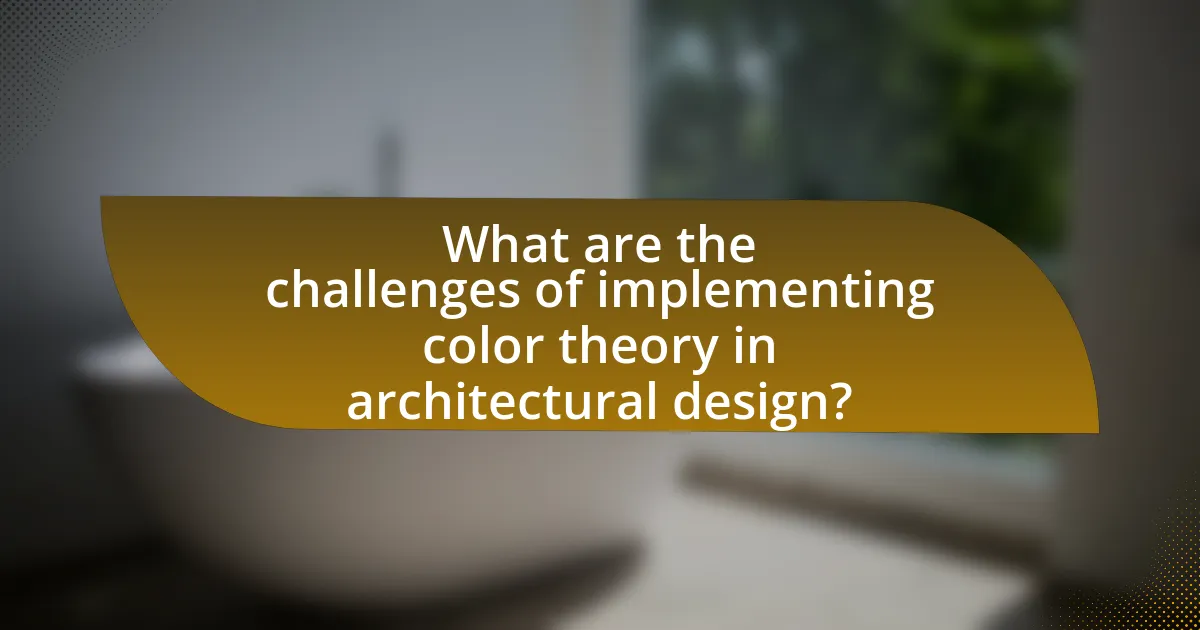The article examines the critical role of color theory in architectural design, highlighting its influence on aesthetics, functionality, and emotional responses within spaces. It discusses how architects utilize color to create visual harmony, guide movement, and enhance spatial perception, with specific attention to the psychological effects of different colors on occupants. Key principles of color theory, such as the color wheel and color harmony, are outlined, along with the importance of cultural interpretations and regional preferences in color selection. The article also addresses the challenges architects face in implementing color theory and offers strategies for effective color application, ensuring that designs resonate with users and enhance their overall experience.

What is the Role of Color Theory in Architectural Design?
Color theory plays a crucial role in architectural design by influencing aesthetics, functionality, and emotional responses to spaces. Architects utilize color to create visual harmony, guide movement, and enhance the perception of space. For instance, warm colors can make a space feel inviting and cozy, while cool colors can create a sense of calm and spaciousness. Research indicates that color can affect mood and behavior; for example, studies show that blue environments can promote tranquility, while red can stimulate energy and excitement. This understanding of color psychology allows architects to design spaces that not only meet functional needs but also resonate emotionally with occupants, thereby enhancing overall user experience.
How does color theory influence architectural aesthetics?
Color theory significantly influences architectural aesthetics by guiding the selection and application of colors to evoke specific emotions and perceptions. Architects utilize color schemes to enhance the visual appeal of structures, create harmony, and influence the spatial experience. For instance, warm colors like red and yellow can create a sense of warmth and energy, while cool colors such as blue and green promote calmness and tranquility. Research indicates that color can affect human behavior and mood, with studies showing that environments designed with thoughtful color choices can improve well-being and productivity. The application of color theory in architecture is evident in iconic buildings, where color not only defines the structure’s identity but also enhances its relationship with the surrounding environment.
What are the fundamental principles of color theory relevant to architecture?
The fundamental principles of color theory relevant to architecture include the color wheel, color harmony, and the psychological effects of color. The color wheel organizes colors into primary, secondary, and tertiary categories, providing a visual guide for selecting color combinations that enhance architectural aesthetics. Color harmony refers to the pleasing arrangement of colors, which can create a cohesive look in a building’s design, often achieved through complementary, analogous, or triadic color schemes. The psychological effects of color influence human emotions and behaviors; for instance, blue can evoke calmness, while red may stimulate energy. These principles guide architects in creating spaces that are not only visually appealing but also conducive to the intended use and experience of the environment.
How do color combinations affect the perception of space?
Color combinations significantly influence the perception of space by altering how individuals interpret dimensions and distances within an environment. For instance, lighter colors tend to make spaces appear larger and more open, while darker colors can create a sense of intimacy and enclosure. Research by the American Institute of Architects indicates that using a monochromatic color scheme can enhance spatial coherence, making areas feel more expansive. Additionally, contrasting colors can delineate different areas within a space, guiding the viewer’s eye and affecting their spatial awareness. Thus, the strategic use of color combinations is essential in architectural design to manipulate spatial perception effectively.
Why is color selection important in architectural design?
Color selection is important in architectural design because it influences aesthetics, functionality, and emotional responses. The choice of color can enhance the visual appeal of a structure, create a sense of harmony with the environment, and affect how occupants feel within a space. For instance, studies show that colors can impact mood; warm colors like red and yellow can evoke energy and warmth, while cool colors like blue and green can promote calmness and relaxation. Additionally, color can affect perceptions of space; lighter colors can make a room feel larger, while darker colors can create intimacy. Therefore, thoughtful color selection is essential for achieving desired architectural outcomes and enhancing user experience.
What psychological effects do colors have on building occupants?
Colors significantly influence the psychological state of building occupants. For instance, blue hues are often associated with calmness and productivity, while red can evoke feelings of excitement or urgency. Research indicates that environments painted in warmer colors, like yellow and orange, can stimulate creativity and social interaction, whereas cooler colors tend to promote tranquility and focus. A study published in the Journal of Environmental Psychology by Küller et al. (2006) found that color can affect mood and behavior, demonstrating that specific colors can enhance or diminish feelings of comfort and well-being among occupants.
How can color enhance or detract from a building’s functionality?
Color can enhance or detract from a building’s functionality by influencing visibility, mood, and thermal performance. For instance, bright colors can improve visibility and safety in urban environments, while darker colors may absorb heat, impacting energy efficiency. Research indicates that lighter colors can reduce cooling costs by reflecting sunlight, as demonstrated in studies showing that buildings painted in light colors can be up to 20% cooler than those in darker shades. Additionally, color can affect psychological responses; warm colors may create a welcoming atmosphere, while cool colors can promote calmness. Thus, the strategic use of color in architectural design directly impacts both the aesthetic appeal and practical performance of a building.

How do different cultures interpret color in architecture?
Different cultures interpret color in architecture through symbolic meanings and emotional associations tied to their historical and social contexts. For instance, in Western cultures, white often symbolizes purity and simplicity, while in many Eastern cultures, it can represent mourning and death. In India, vibrant colors like red signify prosperity and fertility, while blue is associated with the divine. Additionally, in Islamic architecture, green is revered as a sacred color linked to paradise. These interpretations influence architectural choices, as seen in the use of color in buildings, which reflect cultural values and beliefs. For example, the colorful facades of traditional Moroccan riads showcase the importance of color in expressing identity and heritage.
What cultural significance do colors hold in architectural design?
Colors in architectural design hold significant cultural meanings that influence perception and emotional responses. For instance, in many cultures, the color white symbolizes purity and peace, often seen in religious buildings like temples and churches. Conversely, red can represent strength and vitality, frequently used in structures intended to convey power, such as government buildings. Historical context further illustrates this significance; for example, the use of blue in Islamic architecture is rooted in its association with heaven and spirituality, as seen in the Blue Mosque in Istanbul. These color associations are not arbitrary; they are deeply embedded in cultural narratives and traditions, shaping how spaces are experienced and understood by their inhabitants.
How do regional color preferences influence architectural styles?
Regional color preferences significantly influence architectural styles by dictating the hues and tones used in building designs, which reflect cultural identities and environmental contexts. For instance, in Mediterranean regions, warm colors like terracotta and soft yellows are prevalent, aligning with the natural landscape and historical influences, while in colder climates, such as Scandinavia, lighter colors like whites and pastels are favored to enhance light reflection and warmth. This correlation is supported by studies showing that color choices in architecture are often a response to local climate, cultural heritage, and available materials, thereby shaping the overall aesthetic and functionality of structures.
What examples illustrate cultural variations in color usage in architecture?
Cultural variations in color usage in architecture are exemplified by the vibrant use of colors in Indian temples, which often feature bright reds, yellows, and greens symbolizing various deities and cultural beliefs. In contrast, traditional Japanese architecture typically employs a more subdued palette, utilizing natural colors like browns and grays that harmonize with the surrounding environment, reflecting the cultural emphasis on simplicity and nature. Additionally, the use of white in Greek architecture, particularly in the iconic whitewashed buildings of Santorini, symbolizes purity and is deeply rooted in the region’s historical and cultural context. These examples illustrate how different cultures employ color in architecture to convey meaning, reflect beliefs, and enhance aesthetic appeal.
How can architects effectively apply color theory in their designs?
Architects can effectively apply color theory in their designs by understanding the psychological effects of colors and utilizing color harmonies to create desired atmospheres. For instance, warm colors like red and yellow can evoke energy and warmth, while cool colors such as blue and green promote calmness and tranquility. Research indicates that color can influence human emotions and behaviors, which architects can leverage to enhance user experience in spaces. Additionally, employing color schemes like complementary or analogous colors can create visual interest and cohesion in architectural elements, thereby improving aesthetic appeal and functionality.
What tools and resources are available for color selection in architecture?
Tools and resources available for color selection in architecture include color palettes, software applications, and physical samples. Color palettes, such as those provided by Pantone and Sherwin-Williams, offer standardized color options that architects can use to ensure consistency and harmony in design. Software applications like Adobe Color, SketchUp, and ColorSnap allow architects to visualize color combinations and create digital mock-ups of their designs. Additionally, physical samples, such as paint chips and material swatches, enable architects to assess color in real-world lighting conditions, ensuring that the selected colors align with the intended aesthetic and functional goals of the project.
How can architects balance personal style with client preferences in color choices?
Architects can balance personal style with client preferences in color choices by employing a collaborative design process that incorporates client feedback while integrating their own aesthetic sensibilities. This approach involves conducting initial consultations to understand the client’s vision and preferences, followed by presenting color palettes that reflect both the client’s desires and the architect’s design philosophy. Research indicates that effective communication and visual aids, such as color boards or digital renderings, enhance client understanding and satisfaction, allowing architects to guide clients toward informed decisions that align with both parties’ tastes.

What are the challenges of implementing color theory in architectural design?
Implementing color theory in architectural design presents several challenges, including subjective interpretation, cultural differences, and environmental factors. Subjective interpretation can lead to varying perceptions of color, affecting how spaces are experienced by different individuals. Cultural differences also play a significant role, as colors can have distinct meanings and associations in different cultures, complicating the design process for diverse populations. Additionally, environmental factors such as lighting conditions and surrounding landscapes can alter the appearance of colors, making it difficult to achieve the intended aesthetic. These challenges necessitate careful consideration and research to ensure that color choices align with both the design goals and the intended user experience.
What common pitfalls should architects avoid when using color?
Architects should avoid using too many colors in a single project, as this can create visual chaos and detract from the overall design. A limited color palette helps maintain harmony and focus, which is essential for effective architectural design. Additionally, architects must be cautious about neglecting the psychological effects of color; for instance, colors can evoke specific emotions and influence the perception of space. Research indicates that warm colors can make spaces feel smaller and more intimate, while cool colors can create a sense of openness. Lastly, architects should avoid ignoring the context of the environment; colors that clash with the surrounding landscape or architectural style can lead to a disjointed appearance.
How can lighting conditions affect color perception in architecture?
Lighting conditions significantly influence color perception in architecture by altering how colors are viewed and interpreted within a space. Different light sources, such as natural daylight or artificial lighting, emit varying color temperatures, which can enhance or diminish specific hues. For instance, daylight has a higher color temperature, often making colors appear more vibrant and true to their original form, while incandescent lighting, with its warmer tone, can create a yellowish cast that alters the appearance of colors. Studies have shown that the same color can look different under various lighting conditions, impacting the overall aesthetic and emotional response to architectural spaces. This phenomenon is supported by research from the International Journal of Architectural Research, which highlights that color perception is not static but dynamic, influenced by the interplay of light and material surfaces.
What strategies can be employed to overcome color-related design challenges?
To overcome color-related design challenges, designers can employ strategies such as utilizing color theory principles, conducting user research, and implementing color contrast techniques. Utilizing color theory principles, such as the color wheel and complementary colors, helps in selecting harmonious color combinations that enhance visual appeal and functionality. Conducting user research allows designers to understand the emotional and psychological impacts of color on different demographics, ensuring that the chosen palette resonates with the intended audience. Implementing color contrast techniques, such as ensuring sufficient contrast between text and background colors, improves readability and accessibility, which is crucial in architectural design. These strategies are supported by studies indicating that effective color use can significantly influence user experience and perception in built environments.
What best practices can architects follow for effective color application?
Architects can follow several best practices for effective color application, including understanding color theory, considering the psychological impact of colors, and ensuring harmony with the surrounding environment. By applying color theory principles, architects can create spaces that evoke specific emotions and responses; for instance, blue often promotes calmness, while red can stimulate energy. Additionally, architects should assess the context of the building, including cultural significance and local climate, to select colors that enhance the structure’s aesthetic and functional qualities. Research indicates that color can influence perceptions of space, with lighter colors making areas appear larger and darker shades creating intimacy. Therefore, thoughtful color application not only enhances visual appeal but also contributes to the overall experience of the space.
How can architects create cohesive color schemes across different building elements?
Architects can create cohesive color schemes across different building elements by employing a systematic approach that includes color theory principles, material compatibility, and contextual analysis. Utilizing the color wheel, architects can select a harmonious palette by choosing analogous or complementary colors that enhance visual unity. Additionally, they should consider the materials used in each building element, ensuring that colors align with the textures and finishes to maintain consistency. Contextual analysis involves assessing the surrounding environment and cultural influences, which can guide color choices that resonate with the location. Research indicates that cohesive color schemes can improve aesthetic appeal and user experience, as seen in studies highlighting the psychological effects of color in architecture.
What role does technology play in modern color selection for architecture?
Technology plays a crucial role in modern color selection for architecture by enabling precise visualization and analysis of color schemes. Advanced software tools, such as Building Information Modeling (BIM) and color simulation applications, allow architects to experiment with various color palettes in a virtual environment, ensuring that the chosen colors harmonize with materials, lighting, and surrounding landscapes. For instance, tools like Adobe Color and ColorSnap provide instant feedback on color combinations, enhancing decision-making processes. Additionally, technology facilitates the use of data analytics to understand trends in color preferences, which can inform design choices that resonate with contemporary aesthetics and cultural contexts.
How can architects ensure their color choices resonate with users?
Architects can ensure their color choices resonate with users by conducting thorough research on color psychology and cultural associations. Understanding how different colors evoke emotions and perceptions allows architects to select hues that align with the intended experience of the space. For instance, studies show that blue can create a sense of calm, while yellow may stimulate creativity. Additionally, architects can engage users through surveys or focus groups to gather feedback on color preferences, ensuring that the chosen palette reflects the community’s identity and values. This user-centered approach not only enhances satisfaction but also fosters a deeper connection between the space and its occupants.
What methods can be used to gather feedback on color preferences from stakeholders?
Surveys and questionnaires are effective methods to gather feedback on color preferences from stakeholders. These tools allow stakeholders to express their opinions on specific color palettes and combinations, providing quantitative data that can be analyzed for trends. For instance, a study published in the Journal of Environmental Psychology found that structured surveys yield reliable insights into color preferences, helping designers align their choices with stakeholder expectations. Additionally, focus groups can facilitate in-depth discussions, enabling stakeholders to articulate their feelings about color choices in a collaborative setting. This qualitative feedback complements quantitative data, offering a comprehensive understanding of preferences.
How can architects adapt their color strategies based on user experience research?
Architects can adapt their color strategies based on user experience research by analyzing how different colors influence emotions, behaviors, and perceptions in various environments. User experience research often reveals that specific colors can enhance feelings of comfort, safety, or productivity, which architects can leverage to create spaces that meet the needs of their users. For instance, studies have shown that blue hues can promote calmness and focus, while warmer colors like yellow can stimulate creativity and energy. By integrating these insights into their design processes, architects can tailor color palettes that align with the intended use of a space, ultimately improving user satisfaction and functionality.
